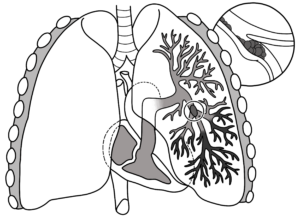
There may actually be a such thing as a pulmonary embolus that does not require treatment.
“ A pulmonary embolism (PE) is the development of a blood clot, usually in the veins of the legs, that travels up and gets stuck in the arteries of the lungs,” says Geoffrey Barnes, MD, cardiologist and vascular medicine specialist at the University of Michigan Health System.
“The standard treatment for a PE is to take a blood thinner (anticoagulant).
“The purpose of the blood thinner is to prevent new blood clots from forming.
“The blood thinner itself will not dissolve away the blood clot that already exists.
“Rather, your body has natural activities that will dissolve the blood clot and help convert it into fibrous scar tissue.
“Sometimes our bodies are able to completely dissolve the blood clot so that we cannot see it anymore with our tests.
“Other times the body dissolves part of the clot, and the rest turns into fibrous scar tissue.”
A Study on Pulmonary Emboli
A study shows that some pulmonary emboli can resolve on their own and do not require treatment.
Conditions that are ripe for blood clot formation in a vein (deep vein thrombosis) include orthopedic surgery, lengthy surgery, old age and prolonged immobility following surgery.
Smoking, use of birth control pills and hardly moving on a long airline flight can also give rise to the development of a DVT. Pregnancy is another risk factor.
DVT can even occur in young adult athletes.
Once a blood clot becomes a pulmonary embolus, grave complications can occur including sudden death.

Pulmonary embolism
This report explains that not all pulmonary emboli require the same aggressive treatment in the form of level of blood thinners.
Diagnostic tests have become increasingly sensitive, and thus, may pick up very small, rather insignificant clots.
These are the clots that can resolve on their own.
So what’s wrong with aggressive treatment for these relatively insignificant clots in the lung?
Treatment for pulmonary embolus typically involves powerful blood thinners that can raise the risk of post-surgical bleeding.
Unfortunately, today’s medical technology does not include an instrument that can distinguish between blood clots that are dangerous and those that do not necessitate treatment.
For instance, the computerized tomography pulmonary angiogram is remarkable at picking up pulmonary emboli, but at the same time, it also detects smaller clots that can go away on their own.
So what’s the solution for now?
The researchers recommend that doctors increase their criteria for blood clot screening prior to ordering blood thinner therapy.
Some criteria may be the location and size of the blood clot.
Hallmark symptoms of a pulmonary embolus are sudden shortness of breath and chest pain.
Additional Symptoms of a Pulmonary Embolus
Swelling in one leg, bluish skin, clammy skin, pronounced sweating, irregular or rapid heartbeat, a weak pulse, fainting and lightheadedness.
The report is in the September 2012 Journal of the American Academy of Orthopaedic Surgeons.

 Geoffrey Barnes, MD,
Geoffrey Barnes, MD,























